As a bonus after Homeland '98, Jette Goldie (the Homeland Con Committee chairwoman) had organized a fast four-day tour of Scottish places and sites that were significant to Highlander. This departed the morning after the Con, twenty tourists plus Jette as guide in a 24-person coach (bus) hauling a luggage trailer behind. The tour started on just the right note when our driver, a fiftyish gentleman named Tom with an appropriately strong Scottish accent and a mischievous gleam in his eye, announced that he would prefer to be called by his name, and if anyone tried to address him as "Driver," he might just answer back "Yes, passenger?".
And we were off.
We headed north out of Glasgow along the M8 and A82 highways. The M8 was not much different from a US interstate, but the A82 rapidly dwindled to a two-lane road, one lane each direction. We followed the A82 north along the west shore of Loch Lomond, getting excellent views of the hills in the area including Ben Lomond. Our first stop was at the north end of Loch Lomond, where everybody spent a number of minutes taking pictures of nearly everything in sight. Every person on the bus had a camera, mostly of the instamatic variety, but one person had a videocamera and two people including yours truly had more versatile rigs. I took several shots of the loch, including a couple of wide-angle panoramas, then switched lenses for some closer pictures of a huge rowan tree whose branches were heavy with the clusters of red berries that mark a rowan in fall.

1. High sun above the head of Loch Lomond, with Ben Lomond center stage.
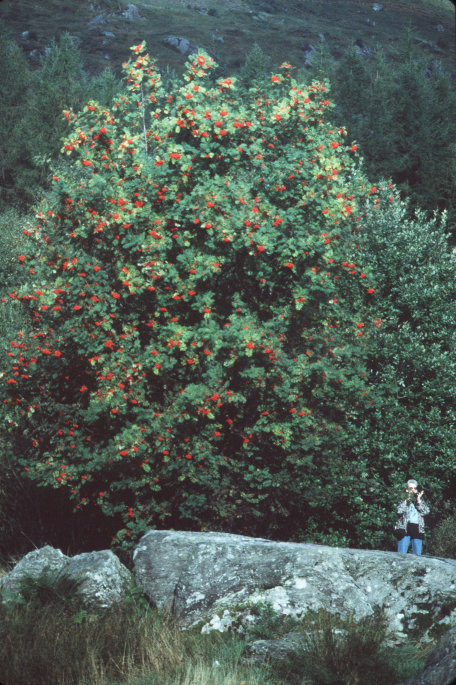
2. Flame-top: A rowan tree laden with clusters of berries demonstrates the second of its Gaelic names. In springtime, its clusters of white flowers also earned it the name "Snow-top."
From Loch Lomond we continued up the A82 to cross Rannoch Moor. The quality of the landscape was like nothing else I've seen before -- it reminded me of the Appalachian Mountains, but where the Appalachians are enormous ridges that run for miles across the landscape, Scottish hills are randomly scattered towers of rock and vegetation. Vegetation is sparse: mostly low scrub and brush, and trees are uncommon except for occasional plantations of Douglas firs. Sheep are everywhere, like woolly maggots on the hillsides -- a legacy of the infamous Highlands Clearances of the late 1700s and early 1800s. There are also many streams of every size and description, and wonderful cascading waterfalls down the hills. Where we have the Appalachian Trail, Scotland has the West Highland Way, a long and winding trail through the western Highlands that takes several days to walk even in good weather.
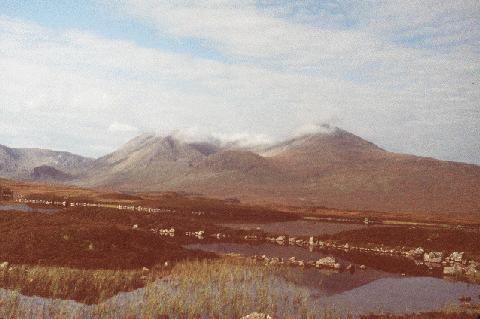
3. Meall a' Bhuiridh (Hill of the Roaring), photographed from the window of our bus just north of the summit of Rannoch Moor.
As we crossed Rannoch Moor, Jette told us the story of the Glencoe Massacre of 1692, in which some forty members of the Macdonalds of Glencoe were murdered by soldiers under the command of a Campbell. The story of the Glencoe Massacre is long and sordid, and illustrates some of the differences between Highlander culture and 'civilized' thought patterns. No one really argued that the Macdonalds didn't deserve it; they were a bunch of thieves and killers, and such raids were not all that rare in those days. What made the Glencoe incident noteworthy is that the soldiers were quartered with the Macdonalds for two weeks before the attack, so the murders were a violation of the ancient traditions of Highland hospitality. Three hundred years later, the Campbells still haven't lived it down.
We stopped for lunch in Fort William, then went on west past Loch Eil to Glenfinnan and the Glenfinnan Monument at the head of Loch Shiel.
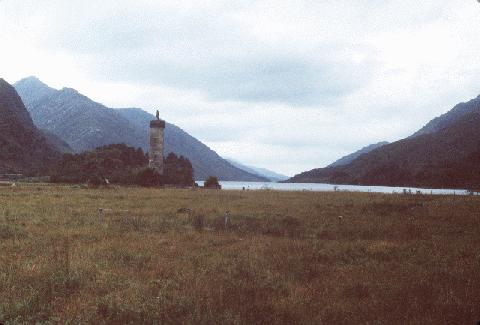
4. The Glenfinnan Monument and Loch Shiel behind it.
The Monument stands at the site where Bonnie Prince Charlie first raised his standard in the Rising of 1745, the last attempt to restore the Stuart line to the Scottish throne. The '45 Rising came close to success, but was crushed by an English army at the Battle of Culloden (more on that later). This statue and a nearby church were both seen in the Highlander episode "Homeland."
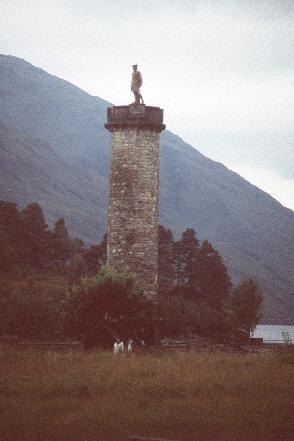
5. A closer view of the Glenfinnan Monument and the statue atop it. The statue has its own name: The Highlander.
Past the Glenfinnan Monument, we stopped briefly in Glenfinnan itself, the hometown of the fictional Highlanders, Connor and Duncan Macleod. We didn't have much time for sightseeing, but we did get a look at a couple of buildings that appeared in the Highlander episode "Homeland." There's the village pub, which unfortunately I did not get any pictures of (don't ask me why), and the village church, which I did photograph. Photographing the interior of a church is somewhat frowned on in some circles; however, I simply couldn't resist.
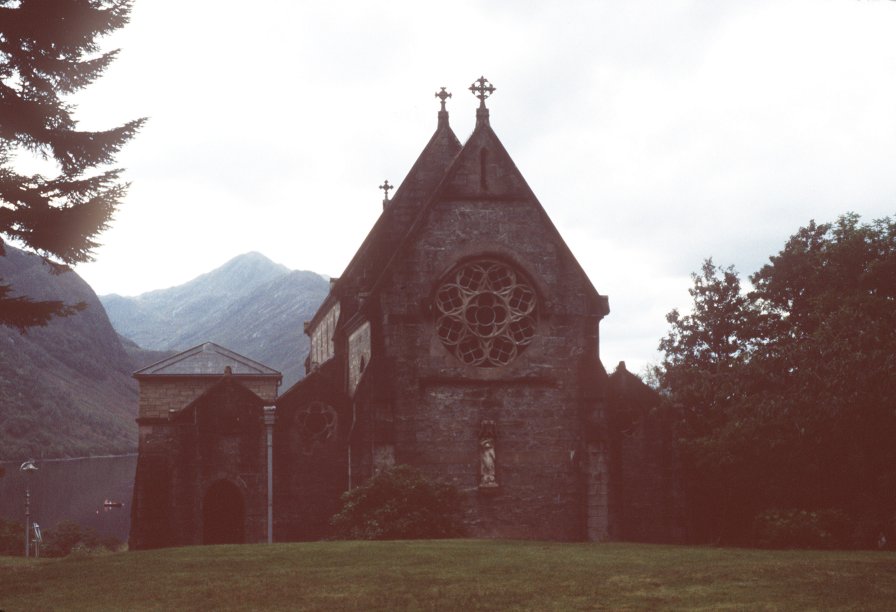
6. The Roman Catholic church in Glenfinnan displays some of the functional beauty of Scottish architecture. Outside . . .
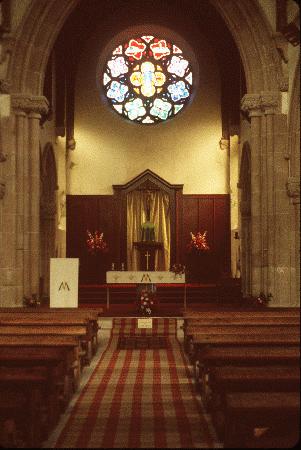
7. . . . and inside.
From Glenfinnan we headed on northwest to Mallaig and the ferry for the Isle of Skye.
That stretch of road was . . . interesting. My first real look at what typical roads are in the Highlands. Around the cities, Glasgow and Edinburgh, you get motorways, analogous to our interstates. Elsewhere in the Lowlands and border areas, you get two-lane roads like our state and county roads. But in the Highlands, many roads are one lane -- for both directions. Every couple of hundred yards there is a wider spot called a "passing place," where one car can wait while another from the other direction passes it. It isn't as much trouble as it might sound; cars are unusual in the Highlands, and you can drive for ten minutes without seeing another one.
These roads follow the old drovers' roads, so they wind around, up, down, and all over the place. So even though it only looks like thirty miles or so on the map, it might be twice that when you count all the curves -- and since nobody with any sense would drive very fast on such a road, you don't cover that distance very quickly. It's awfully easy to get trapped behind a slow-moving vehicle, so Jette and Tom (the driver) allowed plenty of time for the trip to Mallaig. We got there an hour early for our ferry trip, and took the time to prowl the town's shops and see what we could find. Looking over Mallaig, I thought that it looked a lot like a small New England fishing village -- or perhaps it's more accurate to say that a typical New England village looks a lot like Mallaig.
The ferry trip to the Isle of Skye took twenty minutes, aboard a fairly large inter-island ferryship. The weather was chilly, misty, rainy, breezy -- typical weather for a sea cruise, in other words. Once off the ferry on the Isle, we descended on a small shop near the ferry-landing that sells a number of Skye souvenirs. That was amusing: twenty people swarming into a shop that looked like it was used to maybe five customers a day.
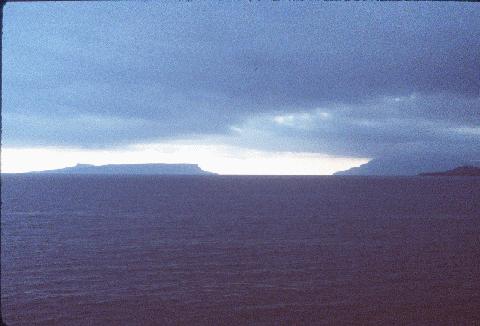
8. Over the sea to Skye: A land- and seascape from the Skye Ferry. Late afternoon, with the sun breaking through the clouds and mist.
By this time, I was wondering the same thing you're probably wondering: does everything in Scotland look like a postcard picture?
The next hour or so was spent winding our way along the Skye roads, most of which were of the one-lane type, to our first night's hotel in Portree. Portree is the largest town on Skye, a community of a couple of thousand on the eastern coast that has a very nice harbor and a small fishing fleet. We stayed in the Portree Hotel; the hotel staff seemed a trifle taken aback by our small horde, but rose magnificently to the occasion.
That night I checked my supplies and discovered that between the Con and that first day, I'd already used most of three rolls of film -- and I'd only brought six rolls with me. That may not sound like much, but these were 36-exposure rolls. And I always use high-speed slide film, which is not common. Fortunately, there was a camera shop down the street from the hotel, so I figured next morning I'd be able to get a couple more rolls there.